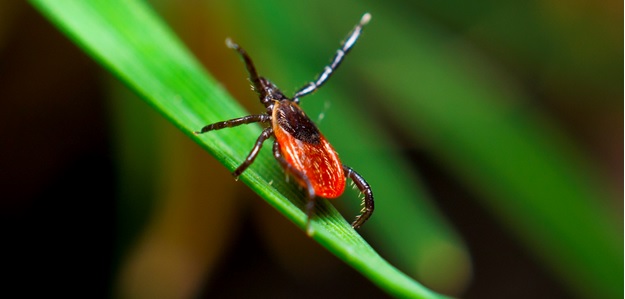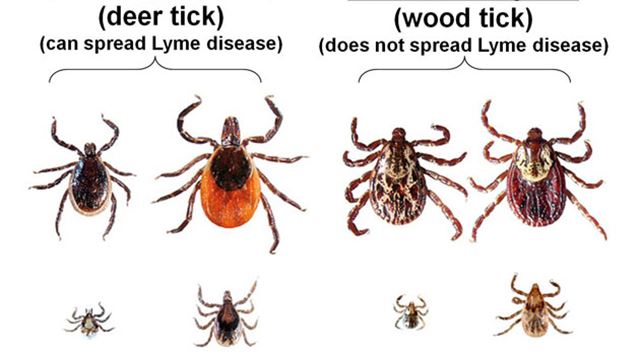Lyme Disease - Wood Ticks

Lyme is a borreliosis caused by borrelia bacteria, which commonly infects animals like birds, mice, other small rodents and deer. Ticks pick up the bacteria by biting infected animals, and then pass it on to other animals, including human hosts. Lyme disease can be successfully treated with antibiotics, particularly when diagnosed early. Risk of infection can be lowered by preventing tick bites.

SYMPTOMS:
There are three stages of Lyme disease and they often blur together quite rapidly.
- Stage 1: Early infection (first few days after infection)
- Stage 2: Infection spreads (days to weeks following infection)
- Stage 3: Chronic Lyme (days to weeks after infection if left untreated, or not properly treated, for months/years after infection)
Lyme disease is most treatable during Stage 1. As time passes, both treatment and diagnosis become more difficult. Symptoms worsen during each stage of infection, ranging from flu-like symptoms to neurological illnesses, including paralysis.
There are over 100 known symptoms of Lyme disease. Common symptoms include:
- Developing a rash, sometimes shaped like a “bull’s eye” mark.
- Initial flu-like symptoms, such as: fever, headache, nausea, jaw pain, light sensitivity, red eyes, muscle aches and neck stiffness.
- While some Lyme victims experience immediate symptoms after infection, others may have none for many months.
TREATMENT/PREVENTION:
Lyme disease can be successfully treated with a 2 – 3 week course of antibiotics. This treatment is most successful when started early. A small percentage of patients may continue to experience non-specific symptoms following successful treatment. This condition is known as post-treatment Lyme disease syndrome and may include symptoms such as sleep disturbance, fatigue, muscle or joint pain and mental confusion (inability to think clearly).
Restricting exposure to potentially infected blacklegged ticks is the key to preventing Lyme disease. The risk of encountering potentially infected blacklegged ticks is greatest in blacklegged tick risk areas where surveillance has revealed established tick populations. Outside of these areas the likelihood of encountering blacklegged ticks is significantly lower. Blacklegged ticks are most commonly found in wooded or forested areas, or along the fringes of such areas, as these locations provide them with a suitable humid habitat in which to survive. When active in these areas it is important to adopt preventative measures such as:
- use trails, whenever possible, and stay to the centre of hiking trails or paths;
- wear light coloured long pants and long sleeved shirts;
- tuck in clothing (pants and socks) to create a barrier;
- use an appropriate tick repellent.
Perform a thorough tick check after spending time outdoors; inspect yourself, your children and your pets for blacklegged ticks and remove any found as soon as possible. Do not stop if you find one tick, as there may be more. Bathing soon after coming indoors is a good way to find any ticks. Be sure to check clothing and items such as backpacks which may have come into contact with vegetation as well. Finding and removing ticks in a timely manner can significantly reduce the likelihood of disease transmission.
PROPER TICK REMOVAL:
The safest rule as regards to how long it takes a tick to transmit a borreliosis to you is, ‘the sooner you remove the tick, the greater the chance of preventing infection’. This is one reason why checking over your body carefully at the end of a long walk in the woods, then showering using a facecloth and back scrubber to scrub the body is usually sufficient to avoid infection even if the tick has already attached because ticks can be brushed off easily if not yet fully attached.
The following tick removal methods are NOT recommended:
- Burning the tick off with a match or cigarette lighter
- “Suffocating” the tick with petroleum jelly or hot oil
- Gripping the tick with thumb and forefinger and tugging at it
Proper Removal: Use a pair of fine-pointed tweezers, and a steady hand, and grasp the mouthparts of the tick, NOT the body of the tick, and slowly pull the tick straight out.
WHAT TO DO WITH REMOVED TICKS:
Once the school has removed the wood tick, place it into a zip lock back and send it home with the student so the parents can determin what to do with it.
Parents may want to do the following:
- you can take a photo and submit it to an image-based identification platform like eTick to help:
- identify the type of tick
- participate in the monitoring of ticks in Canada
- If you are going to see your health care provider and want to bring the tick with you.
- place the tick in a sealable plastic bag or container such as a pill bottle
- record the following information on the label:
- date you were bitten
- body part that was bitten
- geographical location (city, province, territory, and country) of where you were bitten
- Tick testing - done by some local and provincial public health authorities, can help determine
- which bacteria, viruses and parasites are found in ticks
- how the types of bacteria, viruses and parasites found in ticks change over time
- whether new or emerging bacteria, viruses and parasites are occurring in tick
- Tick testing isn't intended to guide diagnosis and treatment of tick-borne diseases. This is because
- a diagnosis of a tick-borne disease is based on:
- travel history
- signs and symptoms
- exposure to ticks
- blood tests, when required
- a health care provider can consider providing preventive treatment after a person has been bitten by a tick, which can occur without tick testing
- a person may have been unknowingly bitten by a different tick
- ticks may not have been attached for enough time to transmit the bacteria, viruses or parasites that can cause tick-borne disease
- Contact your local and provincial public health authorities for additional informaiton
- a diagnosis of a tick-borne disease is based on:


Please provide your question and email address in the fields below.
Your question has been successfully submitted.
CloseThank you.